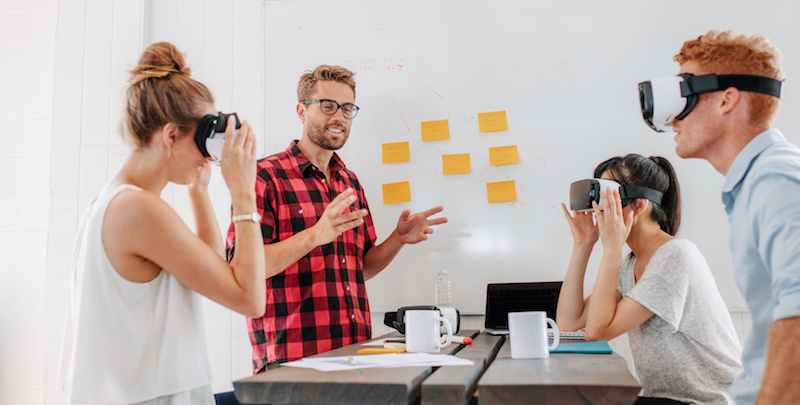Here is the meat of the matter on employee experience and engagement. And it won’t be overcooked like the burnt-out ideas of yesterday such as ping pong tables and latte machines. Don’t get rid of those perks because they are expected, but it’s time to push the envelope, think out-of-the-box and connect with employees in their native tongue.
Your weapons to win the war for talent
Organisations need to adopt a holistic approach to employee engagement, just as they do with customer engagement. Employees are customers. And they want to be catered to.
How do you cater?
You first become people-centric. You get a pulse on what today’s employees expect opposed to what they desire and crave. Reminder ― millennials are now 35% of the workforce and will be 75% by 2025.
Best advice: plan tomorrow, today.
Why do we care?
We care because only 34% of the workforce is engaged, while only 13% are highly-engaged. Disengagement stats aside, the bottom line ― employees’ motives have changed. Thus, organisations who want to be top competitors must change too.
Leftovers: stale engagement today’s employees already expect
Doughnut and dress-down Fridays are like leftovers; they’ve already been chewed on and they won’t attract and retain top talent today.
Check out the list of run-of-the-mill engagement leftovers:
- competitive compensation and benefits, and workplace apps for benefit enrolment
- work/life integration, flexible work hours and work-from-home benefits
- proactive, participative, transparent, and democratic leadership
- autonomy in how work is performed
- input and involvement in decision making
- clear expectations and goals, delivering feedback about progress and improvement
- acknowledgement, recognition, gratitude and encouragement
- employee-hosted lunch and learns
- healthy onsite food and access to fitness equipment
- standards for digital communication with managers (call, text, or email).
The essential but bland list continues. But the millennial entrepreneur mindset hungers for more. They desire a forward-thinking organisation with a buffet of employee experiences (EX). And if you don’t serve such a menu these connoisseurs will leave for an organisation that will fill their hunger pangs.
I won’t batter you with vanilla details about EX. Just check out this list of hors d’oeuvres that will whet their appetites:
Appetisers: attractive engagement today’s employees desire:
- personalised and meaningful work
- participants of corporate social responsibility, an active role in a cause and a purpose
- frequent, proactive, ongoing snap-feedback and conversations
- strengths based personal and professional growth and development opportunities
- employee journey mapping designed around employees’ drivers and desires from hire to retire
- mapping how the work in the weeds impacts the final product or service
- open collaboration and brainstorming in unique social spaces
- mentoring; cross-training; business exposure and projects with high visibility
- in-the-moment-managers who are empathic, caring, trusting and accept smartphone use at work (without snarky looks).
Dessert: salivating engagement today’s employees crave:
- To fully engage millennials, organisations need to disrupt inertia. They need to add sugar and spice to employee value propositions. And offer dessert to complete the full-course meal, such as epic onboarding, orientations and original ongoing experiences to keep them coming back for more.
What does that dessert taste like?
Interactive encounters, connectedness and defining moments ― the kind that creates over-the-top stories, the kind that are social media worthy and inspires stars, likes and shares.
A kind called Immersive EX, a savoury flavour that will revolutionise your culture with a zest that will get people to talk, tweet and Snapchat about your brand.
Escape rooms (e-rooms) are more than just fun recreational adventure games for friends and family. They are now immersive experiences for professionals that:
- attract top talent
- elicit teambuilding
- teach new skills
- market new products.
E-rooms allow employees to bond as they work together to solve problems. Organisations such as Boeing, Nestle-Purina, and Proctor & Gamble have all taken advantage of e-rooms to provide EX and increase employee engagement. In fact, “experiential organisations had more than four times the average profit and more than two times the average revenue.”
Google France has created its own escape game called Première Pièce. Using Google tools, products and apps, participants must solve a series of puzzles together in order to escape.
What sets escape rooms apart from typical training or alternative events where people work together to solve problems is that each individual has the chance to feel like a hero when they find a clue.
Escape Hunt is a leading global provider of escape room experiences, including six locations in Australia (Brisbane, Melbourne and Sydney, etc.). They are redefining escape rooms, shifting from a family and friends fun fad to a teamwork and training tool.
Escape Hunt offers customised corporate friendly game themes. However, unlike the average escape room, they provide a teamwork debriefing after the challenge is complete, where participants explore their behaviour and what they learned about their leadership skills. According to an interview with Rebecca Assice, director and master franchisor at Escape Hunt, “Teamwork is critical here so participants will have to display many competencies that are necessary for a productive workplace environment including communication, leadership, stress management, problem solving and lateral thinking.”
Teams not only take these key learnings back to the workplace to share with their colleagues, they also build trust and forge new relationships with peers that they may have never interacted with in the past. One Trip Advisor leader said, “the entire group got engaged and participated 100%. It got everyone working together from young to old.”
Escape rooms provide employees with the opportunity to learn about their strengths. Another Trip Advisor leader mentioned that it spurred “thought-provoking discussion” about how people interacted with one another.
Top businesses such as Google Sydney, Ernst & Young, Deloitte, and Commonwealth Bank of Australia have given positive feedback about their employee experience with Escape Hunt. A few of their sentiments included that it was a “fantastic experience” from an organisational aspect, “encouraged every member to contribute and work together,” is “perfect for team building, “and it’s a “super fun activity for a team building activity that isn’t cheesy.”
Assice adds that many of their corporate clients agree, “It is the best team building experience they have ever done. Part of the reason for this is it’s team building without it feeling like team building. So teams are having loads of fun while they are working together. It’s also very unique so a change from the same old tired experiences people have done for years.”
Anheuser-Busch brought the escape room experience in-house. They reinvented their hiring process from “beer sampling to career sampling.” Their onboarding e-room is attracting an overwhelming number of quality prospective candidates. Modelled after real employees and real events, candidates get first-hand experience of what it’s like to work at Anheuser prior to applying. Candidates enter a simulated Anheuser-Busch office and are given the challenge to get a new brewery up and running within 15 minutes.
This not only allows Anheuser to bring aboard candidates that desire to be there but also prunes those who don’t fit the Anheuser culture – reducing costly turnover.
The bottom line: organisations can bring aboard the right talent, improve skills, cooperation, engagement, and productivity through teambuilding, and retain talent by making employee experience a priority.

Christine Alexy is a professional writer focused on motivational psychology and leadership development. After 15 years of IT network engineering, Christine re-invented her career when she graduated with honours from Penn State University with a BS in Business Leadership and IT/Security and Risk Analysis.
Dovetailing her professional leadership experience, she is a ghostwriter and researcher for top business leaders and a popular blogger. Christine has supplied extensive research and writing for Steve Van Valin, CEO of Culturology, helping him author a manuscript on purpose and meaning at work. She also ghostwrites high-level content for the HR industry related to ethics and organisational culture. A staunch proponent for meaningful and innovative leadership for today’s multi-generational workforce, Christine regularly shares her insights through her Thought Leadership Thursday blog posts on LinkedIn, @Serve2LeadLyceum on Twitter, and Leadership Lyceum on Google+.

